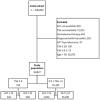Comorbid Hypothyroidism and Low-Alanine Aminotransferase-Associated Sarcopenia Associated with Shortened Survival: A Retrospective Study of 16,827 Patients over a 21-Year Period
- PMID: 39407898
- PMCID: PMC11477861
- DOI: 10.3390/jcm13195838
Comorbid Hypothyroidism and Low-Alanine Aminotransferase-Associated Sarcopenia Associated with Shortened Survival: A Retrospective Study of 16,827 Patients over a 21-Year Period
Abstract
Background: Hypothyroidism is very common worldwide. It is known to be associated with frailty which, in turn, is associated with increased morbidity and mortality in the elderly. Low ALT blood activity is an established marker for sarcopenia and frailty. The incidence and outcomes of the association between low ALT values and hypothyroidism, as manifested in elevated blood TSH levels, is unknown. The objective of this study was to assess if low ALT values could improve the prediction of clinical outcome in hypothyroid patients. Methods: This was a retrospective analysis of hospitalized patients in a large, tertiary hospital. Results: Over a period of 21 years, an overall population of 16,827 patients were identified as eligible to participate in this study. Within the study population, 726 (4.3%) were classified as suffering from hypothyroidism (TSH values > 6 MIU/L) and 2184 (13%) were classified as patients with sarcopenia (ALT < 12 IU/L). Within our patient population, hypothyroidism was associated with sarcopenia in a statistically significant manner (p = 0.011). Patients classified as suffering from both hypothyroidism and sarcopenia had significantly shorter survival: A multivariate analysis showed that the frail and hypothyroid group of patients had a statistically significant risk of mortality in the next 5 years (HR = 3.6; CI 2.75-4.71; p < 0.001). Conclusions: Sarcopenia and frailty are common comorbidities, bearing negative long-term clinical outcomes. Low ALT values could serve as a useful biomarker for screening of patients already diagnosed with hypothyroidism.
Keywords: alanine aminotransferase; frailty; hypothyroidism; prognosis; sarcopenia; survival.
Conflict of interest statement
On behalf of all authors, the corresponding author states that there are no conflicts of interest.
Figures


References
-
- Fried L.P., Tangen C.M., Walston J., Newman A.B., Hirsch C., Gottdiener J., Seeman T., Tracy R., Kop W.J., Burke G., et al. Frailty in older adults: Evidence for a phenotype. [(accessed on 29 January 2024)];J. Gerontol. A Biol. Sci. Med. Sci. 2001 56:M146–M157. doi: 10.1093/gerona/56.3.M146. Available online: https://pubmed.ncbi.nlm.nih.gov/11253156/ - DOI - PubMed
-
- Ajibawo T., Okunowo O. Higher Hospital Frailty Risk Score Is an Independent Predictor of In-Hospital Mortality in Hospitalized Older Adults with Obstructive Sleep Apnea. [(accessed on 15 December 2022)];Geriatrics. 2022 7:127. doi: 10.3390/geriatrics7060127. Available online: https://pubmed.ncbi.nlm.nih.gov/36412616/ - DOI - PMC - PubMed
-
- Tanaka T., Takahashi K., Hirano H., Kikutani T., Watanabe Y., Ohara Y., Furuya H., Tetsuo T., Akishita M., Iijima K. Oral Frailty as a Risk Factor for Physical Frailty and Mortality in Community-Dwelling Elderly. [(accessed on 15 December 2022)];J. Gerontol. A Biol. Sci. Med. Sci. 2018 73:1661–1667. doi: 10.1093/gerona/glx225. Available online: https://pubmed.ncbi.nlm.nih.gov/29161342/ - DOI - PubMed
-
- Hanlon P., Nicholl B.I., Jani B.D., Lee D., McQueenie R., Mair F.S. Frailty and pre-frailty in middle-aged and older adults and its association with multimorbidity and mortality: A prospective analysis of 493,737 UK Biobank participants. [(accessed on 15 December 2022)];Lancet Public Health. 2018 3:e323–e332. doi: 10.1016/S2468-2667(18)30091-4. Available online: https://pubmed.ncbi.nlm.nih.gov/29908859/ - DOI - PMC - PubMed
LinkOut - more resources
Full Text Sources

